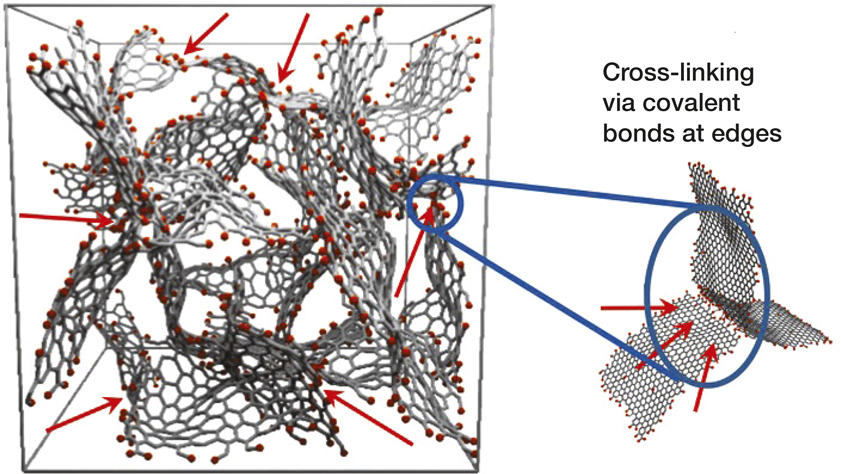A foam made from three-dimension- al cross-linked graphene sheets (3DGraphene) has become the first-known bulk material to demonstrate superelasticity at liquid helium temperatures. The unique property was discovered by researchers at Nankai University in China, where 3DGraphene was developed in 2015. As reported in Science Advances (doi:10.1126/sciadv.aav2589), this work suggests a path toward harnessing the exceptional properties of two-dimensional (2D) materials to create bulk materials with new capabilities.
Carbon nanotubes and graphene exhibit appealing elastic properties, but these tend to weaken when the 2D materials are assembled in bulk form. Five years ago a team of researchers led by Nankai University’s Yongsheng Chen synthesized a mesh-like material from graphene oxide that demonstrated superelasticity from room temperature down to the lowest temperature they could measure with their equipment at that time, which was 77 K.
The material, 3DGraphene, has a structure resembling a honeycomb. The cell walls are micrometer-scale, single-layer graphene sheets. They are randomly oriented and held together at the nodes by carbon–carbon or carbon–oxygen bonds. The cavities between walls are tens of nanometers in dimension.
In this new research, also led by Chen, researchers from Nankai University and Rice University collaborated to measure the elastic properties of 3DGraphene down to deep cryogenic temperatures. Using a customized compression system contained in a vacuum and placed inside a scanning electron microscope, the team flattened samples of 3DGraphene repeatedly over a continuous range of temperatures from 4 K to 1273 K. In situ measurements and scanning electron microscope observations revealed that the elasticity was temperature-invariant; the material behaved as if it was at room temperature even when compressed to one-tenth of its original thickness 100 times at 4 K.

Schematic of the structure of 3D cross-linked graphene. Oxygen atoms are represented by red dots and the covalent bonds by arrows. The spatial density of the oxygen atoms has been adjusted for clarity and does not represent the actual ratio in the material. Credit: Zhao et al.
This result is unprecedented. Until now, bulk materials have always demonstrated temperature-dependent elasticity. “This is the first time the mechanical properties—including Young’s modulus, the mechanical strength, and Poisson’s ratio—have shown temperature-invariant properties in a bulk material,” Chen says. In addition, elasticity is usually thermally activated, causing materials to become brittle and stiff at very low temperatures.
To investigate the source of this unusual behavior, the researchers turned to computer modeling and simulations. They modeled 3DGraphene as a periodic, honeycomb-like graphene network. They gave the cell walls the mechanical properties of single-layer graphene sheets and the nodes the mechanical properties of covalent bonds. The cell walls were allowed to bend and buckle and the covalent bonds to flex in response to compression, as they did in experiments.
Simulations based on this theoretical model yielded mechanical properties that matched those of the experiment, implying that 3DGraphene’s superelasticity and temperature invariance are rooted in the intrinsic properties of 2D graphene and preserved by the cross-linked foam architecture.
“Results from this work will certainly change the way we think about arranging 2D materials in three-dimensional network form,” says Sefaattin Tongay, an assistant professor at Arizona State University with expertise in low-dimensional materials and their applications. Tongay, who was not involved in this study, is optimistic that this cross-linking technique could lead to advances in the areas of catalysts and thermal management, among others. “While the results are strictly on graphitic materials systems, it will be only a matter of time before similar concepts will be applied to other layered materials systems,” he says.
Chen and his team are already applying their technique to other 2D materials systems with the hope of creating bulk materials with unprecedented optoelectronic, conducting, and magnetic properties. “[2D materials] have excellent properties, but if we really want to use them in commercial applications, we have to be able to make them in large-scale and stable states,” Chen says. “One way to do that is to build 3D-crosslinked materials with 2D building blocks,” he says.


